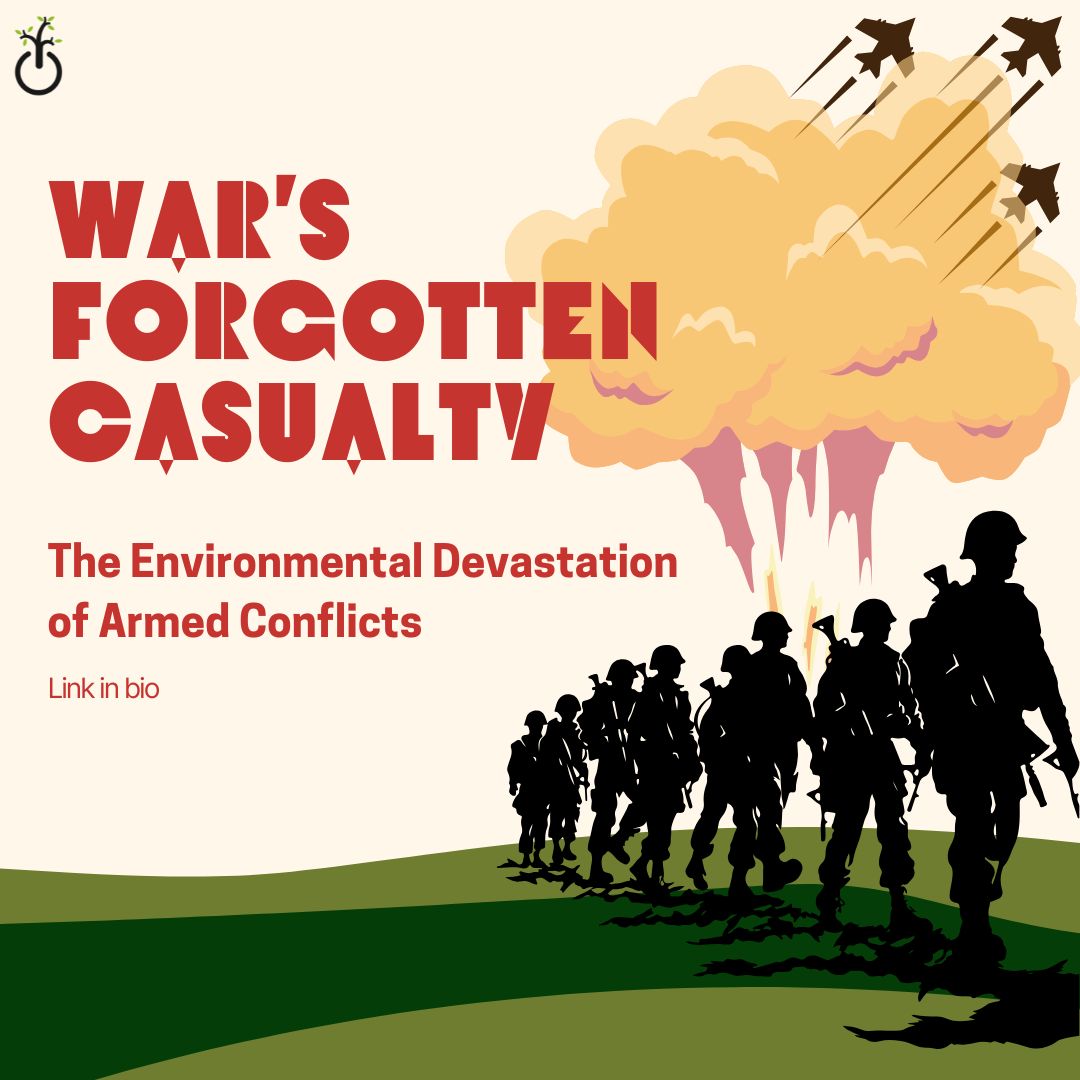Throughout history, wars have left a devastating impact on society, the economy, and politics. As environmental concerns take centre stage in global discussions, the ecological toll of armed conflicts is becoming harder to ignore. These consequences, such as widespread destruction, pollution, and habitat loss, have immediate and lasting consequences on ecosystems. The overall environmental costs of war are overwhelmingly destructive, leaving long-term damage that far outweighs any potential recovery.
Short term consequences
Firstly, militaries are estimated to be responsible for 5.5% (Weir, The Guardian) of global greenhouse gas emissions. If the military were a country, it would be placed 4th as most polluting, between Russia and India. In fact, the US military alone contributed more greenhouse gas emissions than over 150 countries.
During conflicts, trying to debilitate and weaken the enemy without causing civilian casualties has always been a crucial strategy. Infrastructures, storage, military and energy locations play a vital role in the evolution of conflicts and they probably represent the most targeted objectives. If they are hit, the impact can be dramatic.
Researchers in Ukraine estimated the carbon footprint of the first year of war to be 120 million tonnes of CO2e, equivalent to the Netherland’s yearly emissions. Ammunition and explosives alone accounted for 2 million tonnes of CO2e, equivalent to 13 billion kilometres of driving. Additionally, ammunition and explosives produce dust and gases, which harm the areas that are directly involved and also those around, due to the spreading function of the wind. Old buildings sometimes contain toxic materials which are harmful for humans, such as asbestos. Evidently, this single war has had a catastrophic impact on its society, and also the environment.
The destructive nature of war, particularly on infrastructure in order to disable the enemy has further consequences on the environment. For instance, in the absence of electricity water filtering/depuration systems may shut down, allowing potentially toxic liquids to enter rivers and other water streams without proper treatment. This can lead to immensely catastrophic consequences on local water habitats and contaminate drinking water for land species (including of course, humans). Moreover, construction plays an important role in CO2 emissions, accounting for 42% of global greenhouse gas emissions (architecture 2030). If buildings are hit, they may have to be rebuilt. On one side this may entail rebuilding using sustainable materials, improving insulation in buildings, and installing reflective roofs, but this process requires energy and resources nonetheless.
Long term consequences
The long-term consequences of war on the environment are more severe, and are often defined by irreversible damage to ecosystems, biodiversity, and natural resources. One of the most striking examples of this destruction was what led to the birth of the concept of ecocide. First proposed during the Vietnam War by biology professor Arthur W. Galston, the term ecocide refers to the deliberate devastation of ecosystems, such as the U.S. military’s use of the herbicide Agent Orange between 1961 and 1971. The powerful defoliant was sprayed over vast areas of the Vietnamese countryside, destroying crops and forests, causing not only immediate environmental destruction but also long-term harm to both human health and biodiversity.
Beyond deliberate environmental attacks, the indirect effects of war are equally damaging. Explosions often lead to wildfires, consuming large areas of forest and displacing wildlife. Military transport, including tanks, planes, and ships, contributes significantly to pollution, both in terms of air quality and noise. The relentless noise of war machinery agitates animals, disturbing migration patterns and threatening their survival. In the past, animals were often employed directly in warfare, and even today, many are used in military research, adding another layer of exploitation. These impacts accumulate over time, creating zones of environmental collapse that extend far beyond the immediate battlefield.
Nuclear warfare poses an even greater long-term environmental threat. The detonation of nuclear weapons results in immediate, catastrophic destruction, but the lingering environmental effects are arguably even more destructive. Nuclear fallout contaminates soil, water, and air with radioactive particles, leading to long-lasting damage to ecosystems. The nuclear explosions in Hiroshima and Nagasaki, in addition to modern nuclear testing in remote regions, have shown that radiation can cause mutations in plants and animals. In addition, the concept of a “nuclear winter” suggests that large-scale nuclear conflict could lead to significant global cooling, as soot and debris would block sunlight for extended periods. These long-term consequences extend beyond human casualties, threatening entire ecosystems and the planet’s ability to sustain life.
Steps at preventing further damage
Acknowledging the disastrous environmental toll of armed conflict, some international efforts have been made to mitigate these effects. On November 5th, 2001, the UN General Assembly introduced the International Day for Preventing the Exploitation of the Environment in War and Armed Conflict. It was aimed at raising awareness and encouraging global action. Additionally, the PERAC (Protection of the Environment in Relation to Armed Conflicts) initiative, launched in 2013, seeks to strengthen the legal framework protecting the environment during wars. It builds on recommendations from the UN Environment Programme in 2009, which called for greater attention to the environmental consequences of warfare. Despite these somewhat legally binding actions, there remains a significant need for stronger international legal mechanisms and greater global commitment to protect ecosystems from the destructiveness of war.
While the immediate effects of war on society and infrastructure are well-documented, the often overlooked environmental impact is catastrophic, and can not be ignored. Military operations, from their carbon footprint to the destruction of ecosystems and wildlife, contribute significantly to climate change and biodiversity loss. As wars continue to ravage not just human lives, but also the ecosystems on which future generations depend, the urgent need for action in all currently active warfare cannot be overstated.
By Elena Molinari and Federico Salvini
https://www.nature.com/articles/s41893-023-01146-0
https://www.un.org/unispal/wp-content/uploads/2024/06/environmental_impact_conflict_Gaza.pdf
https://www.nytimes.com/2022/04/13/science/war-environmental-impact-ukraine.html
https://www.ncbi.nlm.nih.gov/pmc/articles/PMC6293880
https://theconversation.com/how-to-assess-the-carbon-footprint-of-a-war-215575
https://www.geopop.it/anche-lambiente-e-vittima-delle-guerre-i-danni-ambientali-dei-conflitti
https://www.ilpost.it/2022/05/01/danni-guerra-ucraina-ambiente




